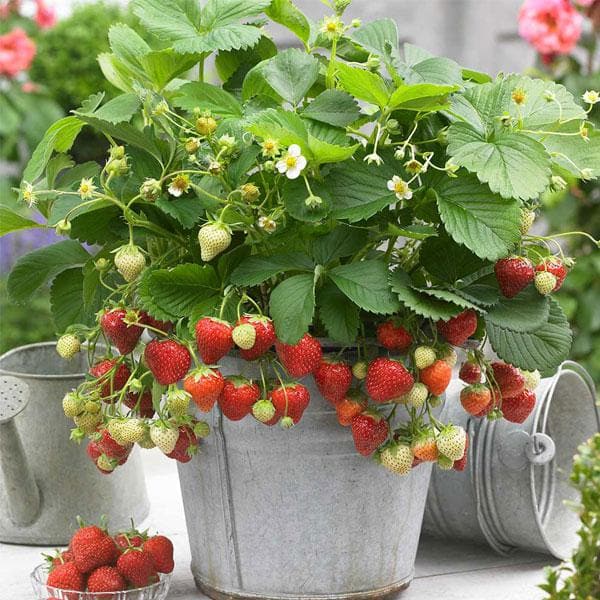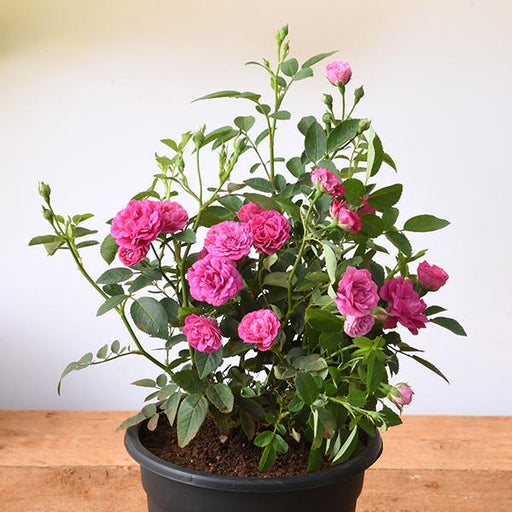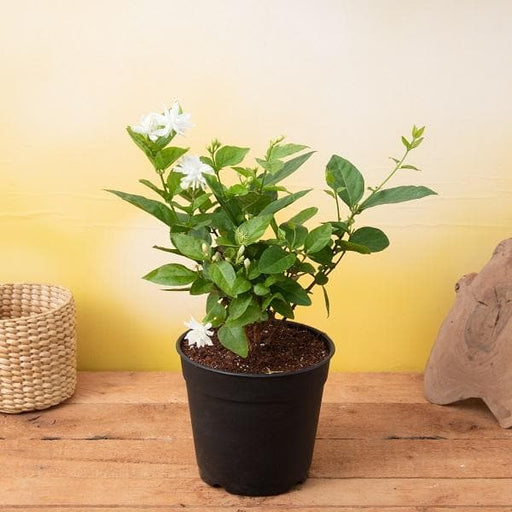
Strawberry - Plant
(MRP Inclusive of all taxes)
- Shipping ₹79 for entire order
- Dispatch in 7 days
- Country of origin: India

(MRP Inclusive of all taxes)
 Save 29%
Save 29%
Air Purifier Money Plant with Pot The Air Purifier Money Plant, also known as Pothos or Epipremnum aureum, is a stunning indoor plant that...
View full details
 Save up to 15%
Save up to 15%
Peace Lily, Spathiphyllum - Plant The Peace Lily, scientifically known as Spathiphyllum, is a stunning houseplant celebrated for its elegant white...
View full details
 Save 25%
Save 25%
Jasminum sambac, Mogra, Arabian Jasmine - Plant Jasminum sambac, commonly known as Mogra or Arabian Jasmine, is a fragrant flowering plant...
View full details
 Save 18%
Save 18%
Combo Constituents Includes the Parijat Tree (Night-Flowering Jasmine), a culturally significant plant with fragrant flowers. Description The Pari...
View full details
 Save 25%
Save 25%
Miniature Rose, Button Rose (Any Color) - Plant The Miniature Rose, also known as the Button Rose, is a charming and compact flowering plant that ...
View full details Save 25%
Save 25%
Damascus Rose, Scented Rose (Any Color) - Plant The Damascus Rose, also known as Rosa damascena, is a timeless symbol of beauty and romanc...
View full details
 Save 17%
Save 17%
Beautiful Fragrant Mogra, Arabian Jasmine Plant with Pot The Beautiful Fragrant Mogra, also known as Arabian Jasmine (Jasminum sambac), is...
View full details Save 15%
Save 15%
Pack of Vermicompost and Neem Cake for House Plants Transform your indoor garden with our premium Pack of Vermicompost and Neem Cake, spec...
View full details
Pack of Plant Growth and Flower Boosters Unlock the full potential of your garden with our Pack of Plant Growth and Flower Boosters! This ...
View full details Save 38%
Save 38%
Combo of Jeevamrut and Neem Raksha for Easy Growth and Protection of Houseplants Transform your indoor garden with our exclusive combo of ...
View full details Save 22%
Save 22%
Plant Nutrients Kit (Pack of 16) for a Healthy Garden Transform your garden into a lush paradise with our Plant Nutrients Kit, featuring 1...
View full details Save 16%
Save 16%
Combo of Top Plant Fertilizers Elevate your gardening game with our exclusive Combo of Top Plant Fertilizers, featuring two bags of premiu...
View full details Save 24%
Save 24%
Pack of 4 Additives to Make Soil Healthy and Nutrient Rich Transform your garden into a thriving ecosystem with our Pack of 4 Additives de...
View full details Save 30%
Save 30%
Transform your gardening experience with our premium Combo of Perlite and Vermiculite. This unique blend is designed to enhance soil aeration and ...
View full details Save 27%
Save 27%
Combo of 2 Vermicompost and Cocopeat - Enrich Your Soil Naturally! Transform your garden into a thriving ecosystem with our Combo of 2 Ver...
View full details
 Save 35%
Save 35%
Best 6 Plants for Perfect Indoor Garden Transform your living space into a lush oasis with our curated collection of the Best 6 Plants for a...
View full details
 Save up to 50%
Save up to 50%
Mini Succulent Garden Pack Transform your space with our Mini Succulent Garden Pack, featuring a delightful collection of 4 any variety beautiful s...
View full details
 Save 30%
Save 30%
5 Best Fragrant Plants Transform your garden or indoor space into a fragrant paradise with our curated selection of the 5 Best Fragrant Plants. Th...
View full details
 Save 24%
Save 24%
Set of 2 Bonsai Looking Grafted Adeniums Transform your indoor or outdoor space with our exquisite Set of 2 Bonsai Looking Grafted Adenium...
View full details Save 45%
Save 45%
Top 4 Die Hard Succulents Pack Transform your indoor or outdoor space with our Top 4 Die Hard Succulents Pack, featuring a curated selecti...
View full details
 Save 30%
Save 30%
5 Best Indoor Plants Pack Transform your living space into a lush oasis with our '5 Best Indoor Plants Pack.' This carefully curated collection fe...
View full details
 Save 25%
Save 25%
Set of 4 Evergreen Air Purifier Plant Pack Transform your indoor space into a lush, green oasis with our Set of 4 Evergreen Air Purifier Pla...
View full details| SrNo | Item Name | Qty |
|---|---|---|
| 2 | Strawberry Plant in 5 inch (13 cm) Pot | 1 |
The Strawberry Plant (Fragaria × ananassa) is a beloved perennial that produces sweet, juicy berries, making it a favorite among gardeners and fruit lovers alike. Known for its vibrant red color and delightful aroma, strawberries are not only delicious but also packed with vitamins, antioxidants, and dietary fiber. This versatile plant thrives in various climates, making it a popular choice for home gardens and commercial farms.
What makes the Strawberry Plant special is its ability to produce fruit in the first year of planting, providing a quick reward for gardeners. Additionally, strawberries are known for their unique flavor profile, which varies by variety, ranging from sweet to slightly tart. With over 600 varieties available, there’s a strawberry for every palate!
One of the standout features of the Strawberry Plant is its ability to propagate through runners, allowing gardeners to expand their strawberry patch with minimal effort. This self-propagating nature not only makes it easy to grow but also contributes to sustainable gardening practices.
Strawberry plants can contribute positively to the environment by attracting pollinators and improving soil health. Their ability to grow in diverse conditions makes them an excellent choice for sustainable gardening practices. Additionally, growing strawberries at home reduces the carbon footprint associated with transporting commercially grown berries.
When it comes to strawberries, variety is the spice of life! From the classic June-bearing to the ever-popular everbearing, each type has its own personality. June-bearing strawberries are like the overachievers of the fruit world, producing a bountiful harvest in a short time. Everbearing strawberries, on the other hand, are the laid-back types, offering a steady supply throughout the growing season. Then there are day-neutral strawberries, the free spirits that don’t care about day length and just want to produce fruit whenever they feel like it. So, whether you’re a fan of sweet, juicy berries or prefer a more tart flavor, there’s a strawberry variety out there just waiting to tickle your taste buds!
Planting strawberries is like setting the stage for a fruity Broadway show. First, choose a sunny spot because strawberries are sun-worshippers, craving at least six hours of sunlight a day. Next, prepare the soil like a gourmet chef would prep a fine meal—loosen it up, add some compost, and ensure it drains well. When planting, give each strawberry plant enough space to stretch its roots and spread its leaves, like they’re auditioning for a role in the garden. Water them regularly, but don’t drown them; they prefer a light misting over a torrential downpour. With these tips, your strawberry plants will be ready to steal the show!
Caring for strawberry plants is like nurturing a diva—give them attention, and they’ll reward you with sweet, luscious fruit. Regular watering is essential, but don’t let them sit in soggy soil; they’re not fans of a wet blanket. Mulching is a must, as it keeps the weeds at bay and helps retain moisture, allowing your strawberries to shine. Fertilizing is like giving them a backstage pass to the good stuff; a balanced fertilizer will keep them thriving. And don’t forget to check for pests! Aphids and slugs can be the uninvited guests at your strawberry party. With a little TLC, your strawberry plants will be the stars of your garden!
Harvesting strawberries is like a treasure hunt, but instead of gold, you’re after those ruby-red gems. The key is to pick them at the right time—when they’re fully red and slightly soft to the touch. If they’re still green or too firm, they’re just not ready for their close-up. Gently twist the berry off the stem, leaving the green cap behind; it’s all about that finesse! And remember, strawberries don’t ripen after being picked, so don’t be tempted to pluck them too early. Once you’ve gathered your bounty, enjoy them fresh, or get creative in the kitchen. Your taste buds will thank you for this delightful adventure!
Just like any star, strawberry plants can face their fair share of drama, especially when it comes to diseases. Fungal infections like powdery mildew and gray mold can crash the party, turning your vibrant plants into sad, wilted versions of themselves. But fear not! Prevention is key—ensure good air circulation and avoid overhead watering to keep those pesky fungi at bay. If disease strikes, act fast! Remove affected leaves and consider organic fungicides as your secret weapon. Remember, a healthy plant is a happy plant, so keep an eye out for any signs of distress. With a little vigilance, your strawberries can avoid the drama and keep shining bright!
Pests are the uninvited guests at your strawberry soirée, and they can be quite the nuisance. Aphids, spider mites, and slugs are the usual suspects, each with their own unique way of ruining your berry bash. Aphids are like the clingy friends that suck the life out of your plants, while spider mites are the sneaky ones that spin webs of trouble. Slugs? They’re the slow movers that munch their way through your precious strawberries. To keep these pests at bay, introduce beneficial insects like ladybugs, or use organic repellents. A little vigilance goes a long way, ensuring your strawberries remain the life of the garden party!
When it comes to gardening, strawberries love a good social life! Companion planting is the secret to a thriving garden, and strawberries have a few favorite pals. Basil is like the best friend that enhances their flavor, while borage attracts pollinators, ensuring a fruitful harvest. Marigolds are the bodyguards, keeping nematodes and other pests at bay. Just be cautious with plants like cabbage and broccoli; they can be the party poopers that compete for nutrients. By choosing the right companions, you’ll create a harmonious garden ecosystem where strawberries can flourish and make new friends!
Who doesn’t love a good strawberry jam? It’s like summer in a jar! Making your own jam is a delightful way to preserve the sweetness of your strawberry harvest. Start with fresh, ripe strawberries, sugar, and a splash of lemon juice for that zing. Cook them down until they reach that perfect spreadable consistency, and voilà! You’ve got a delicious treat that can elevate your breakfast toast or serve as a sweet topping for desserts. Experiment with flavors by adding herbs like mint or basil for a twist. Your homemade strawberry jam will have everyone asking for the secret recipe!
If you’re looking for a refreshing way to enjoy strawberries, look no further than smoothies! These fruity concoctions are like a party in a glass, and strawberries are the star of the show. Blend them with yogurt, banana, and a splash of orange juice for a classic treat, or get adventurous with spinach and almond milk for a green twist. Add a scoop of protein powder for an extra boost, and you’ve got a nutritious snack that tastes like dessert. The best part? You can customize your smoothie to suit your mood, making every sip a delightful surprise!
When it comes to desserts, strawberries are the ultimate showstoppers! From classic strawberry shortcake to decadent chocolate-covered strawberries, the possibilities are endless. They can be the star of a fruit tart, adding a burst of color and flavor, or blended into a creamy cheesecake for a fruity twist. Don’t forget about strawberry ice cream—perfect for those hot summer days! The beauty of strawberry desserts is that they’re not just delicious; they’re also a feast for the eyes. With their vibrant color and sweet aroma, strawberries can turn any dessert into a masterpiece that will impress your guests!
Strawberries are not just a pretty face; they’re packed with nutrition! These little red gems are low in calories but high in vitamins, making them a guilt-free indulgence. Rich in vitamin C, they boost your immune system and keep your skin glowing. Plus, they’re loaded with antioxidants that fight off free radicals, helping you stay youthful and vibrant. With fiber to aid digestion and potassium for heart health, strawberries are the ultimate superfood. So, the next time you enjoy a bowl of strawberries, remember you’re not just treating your taste buds; you’re giving your body a healthy boost!
The best time to plant strawberries is in early spring or late fall. This way, your plants can establish roots before the heat of summer or the chill of winter. Think of it as giving them a cozy blanket before they face the elements. Timing is everything, just like in comedy!
Strawberry plants are sun worshippers, craving at least 6-8 hours of sunlight daily. They thrive in bright, sunny spots, so don’t let them get too shady! If they could wear sunglasses, they would. Remember, a happy strawberry is a sun-kissed strawberry, ready to sweeten your day!
Water your strawberry plants about once a week, or more during dry spells. They prefer their soil moist but not soggy—think of it as a spa day, not a drowning! A good rule of thumb is to check the top inch of soil; if it’s dry, it’s time for a refreshing drink!
Strawberries love well-draining, loamy soil with a pH of 5.5 to 6.8. They’re not picky eaters, but they do appreciate a nutrient-rich buffet! Mix in some compost to give them a gourmet experience. Remember, happy roots lead to juicy fruits, and nobody wants a sad strawberry!
To keep pests at bay, consider using row covers or organic insect repellents. Strawberries are like the divas of the garden, needing a little extra protection. You can also introduce beneficial insects like ladybugs, who are the bouncers of the garden party, ensuring only the good bugs get in!
Strawberries usually bear fruit in late spring to early summer, depending on the variety. It’s like waiting for your favorite band to drop a new album—exciting and worth the wait! Once they start producing, you’ll be singing their praises as you enjoy the sweet rewards of your labor.
Ripe strawberries are a vibrant red, plump, and slightly soft to the touch. If they look like they’ve just come back from a tropical vacation, they’re ready to be picked! Avoid the green ones; they’re still in the “I need more sun” phase. Trust your eyes and taste buds!
Absolutely! Strawberries are container-friendly and love to hang out in pots, hanging baskets, or even vertical gardens. Just ensure they have enough sunlight and drainage. It’s like giving them a penthouse suite in your garden—perfect for those who want to enjoy fresh strawberries without a yard!
You can propagate strawberries through runners, seeds, or division. Runners are like the adventurous siblings that spread out and start new families. Just snip them off and plant them elsewhere. It’s a family reunion you’ll want to host, leading to more strawberries for everyone!
Strawberry plants can face foes like powdery mildew, root rot, and gray mold. It’s like a horror movie for your garden! Keep an eye out for signs and practice good hygiene—remove any infected leaves and ensure proper spacing for airflow. Prevention is key; nobody wants a garden drama!
Strawberry plants can live for about 3-4 years, but they’re like the party guests who overstay their welcome. After a few years, their fruit production may decline. To keep the party going, consider replanting new varieties every few years. Fresh faces keep the garden lively and fruitful!
Some top strawberry varieties include June-bearing, everbearing, and day-neutral types. June-bearing is the diva, producing a big crop in early summer, while everbearing and day-neutral are the reliable friends who keep the strawberries coming throughout the season. Choose your favorites and enjoy a berry good time!